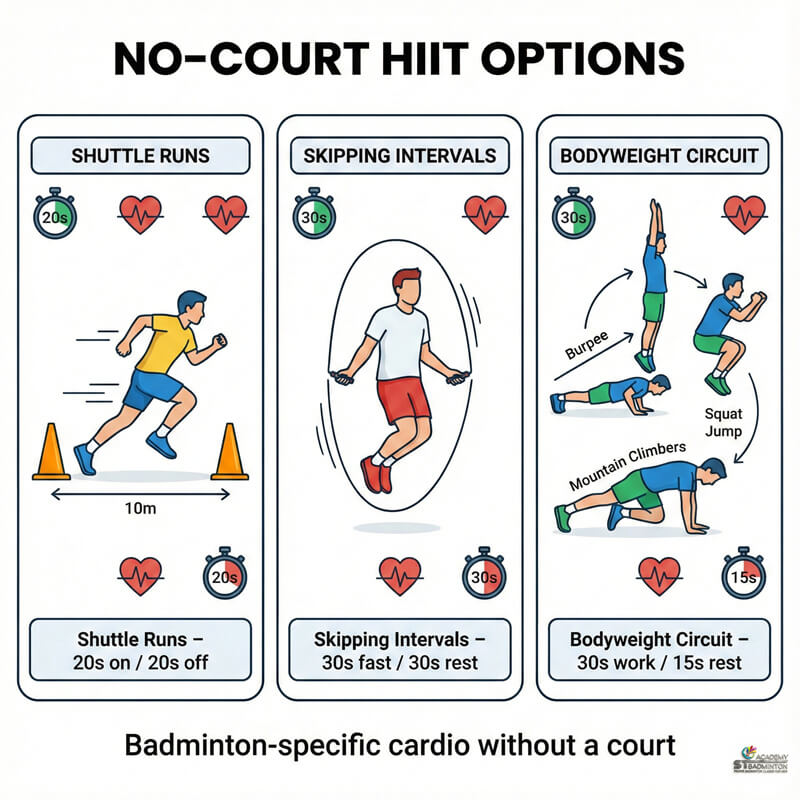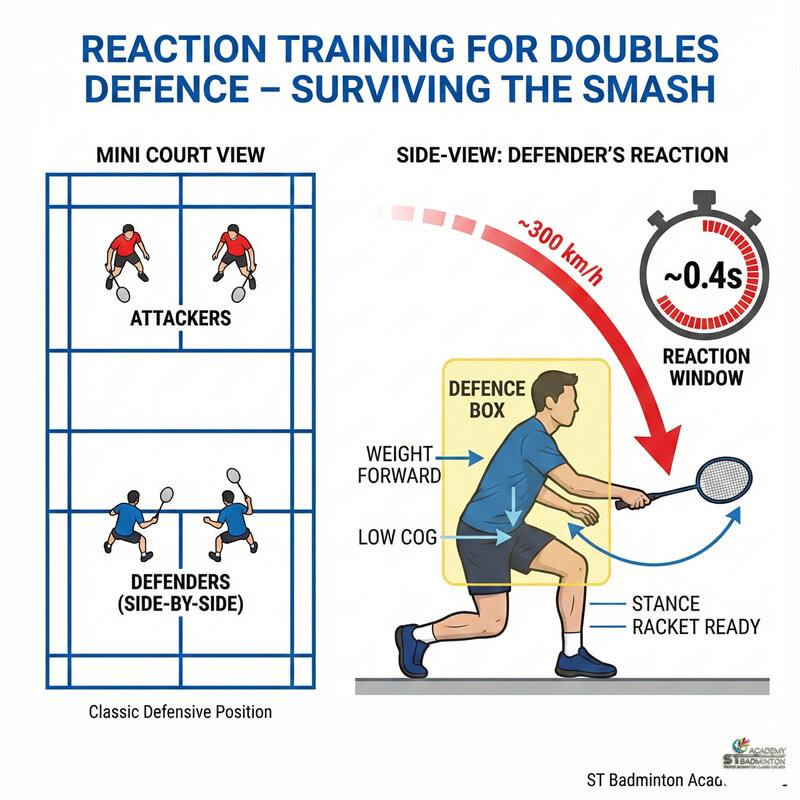Optimize Your Badminton Recovery With Professional Player Tips (Malaysia & Singapore)
As a coach watching players in Malaysia and Singapore, I notice many train hard but “wing it” when it comes to recovery. Once we borrow a few simple routines used by professional players – proper cool down, better sleep habits and smart nutrition – their energy and performance usually feel very different within a few weeks. This guide helps school team players, serious juniors and busy adults in Setapak, Wangsa Maju, Kepong, Cheras and surrounding areas understand how to recover better between badminton sessions and tournaments using practical ideas inspired by professional player routines.
A certified badminton coach explains recovery strategies that top level players use and how Malaysia and Singapore badminton players can adapt them realistically for club training, school competitions and busy work schedules.
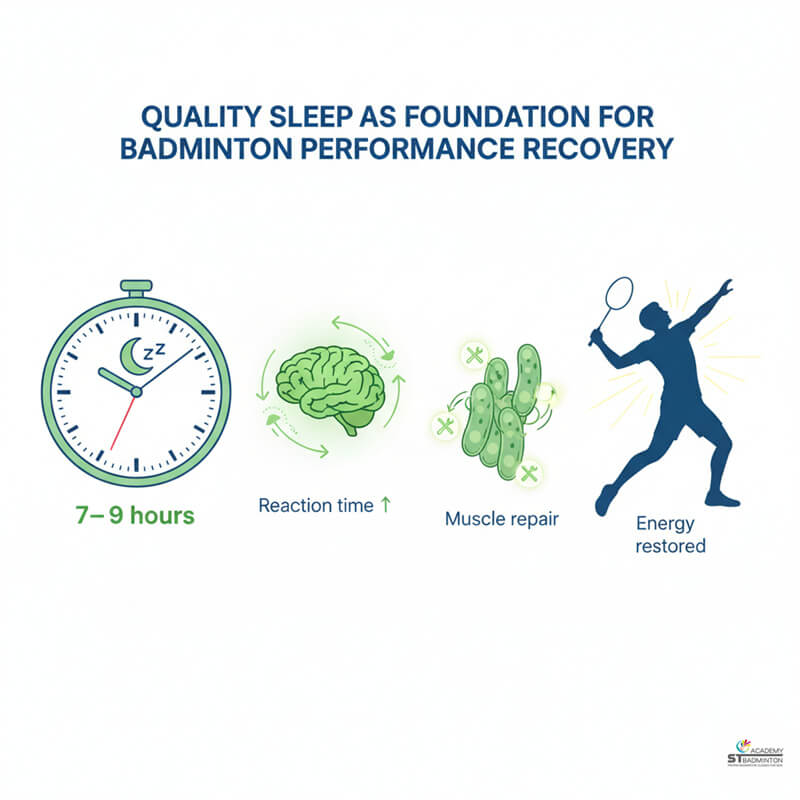
Recovery Priority #1
Quality Sleep As Foundation For Badminton Performance Recovery
Professional badminton players protect sleep as their primary recovery tool because consistent seven to nine hours nightly supports muscle repair, reaction time restoration and decision-making capacity needed for high-level competition. Quality sleep allows the body to clear metabolic waste from intense training, rebuild damaged muscle tissue and consolidate movement patterns learned during technical practice, making it more valuable than any expensive recovery equipment or supplement for players across Malaysia and Singapore.
School team players from Setapak, Wangsa Maju and Cheras can apply professional sleep habits by maintaining regular bedtimes even during tournament weekends, reducing screen time one hour before sleep, and keeping bedrooms dark and cool despite warm Malaysian weather. Our certified coach at ST Badminton Academy emphasises that young athletes need adequate sleep for both athletic recovery and cognitive development required for academic performance alongside badminton training.
Working adults from Petaling Jaya, Subang Jaya and Singapore areas like Jurong or Clementi who train after work should prioritize sleep quality over adding extra evening sessions, as chronic sleep debt reduces training benefits and increases injury risk more than missing occasional practice.
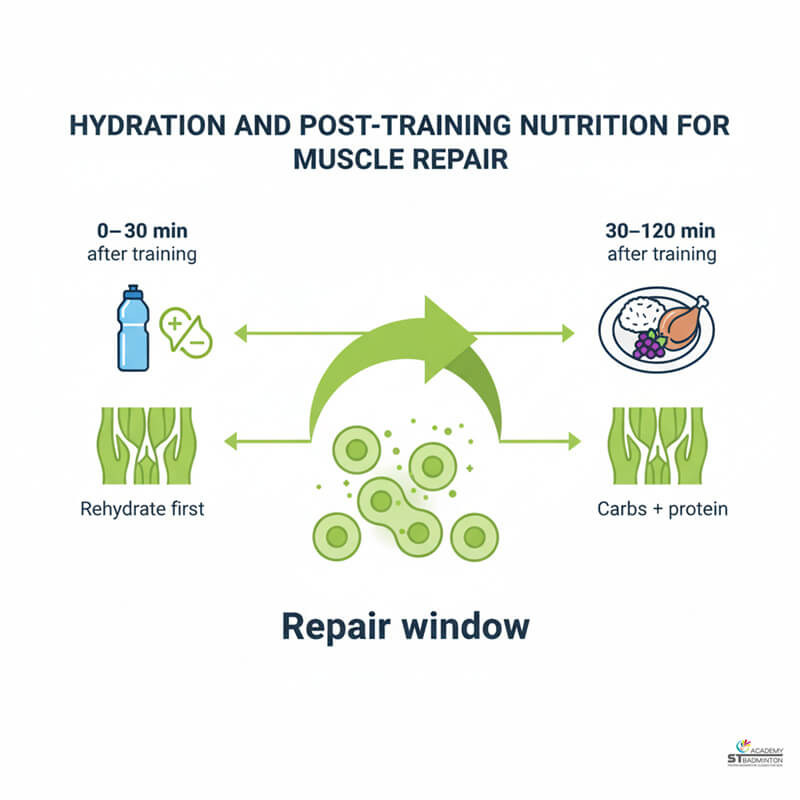
Recovery Priority #2
Hydration And Post Training Nutrition For Muscle Repair
Professional players follow structured hydration and nutrition protocols after training because adequate fluid replacement and timely nutrient intake significantly accelerate muscle recovery and glycogen restoration needed for next-day performance. Simple post-session strategies include rehydrating with water plus electrolytes to replace sweat losses from humid Malaysian and Singaporean conditions, followed by a meal or snack containing carbohydrates and protein within one to two hours to support tissue repair and energy replenishment.
Players from Selayang, Kepong and Ampang can apply professional nutrition habits through accessible local foods rather than expensive supplements, using rice-based meals with chicken or fish, noodle dishes with lean protein, fresh fruits like bananas or papayas, and simple home-cooked options that provide recovery nutrients without complex meal planning. Our coaching team at ST Badminton Academy teaches that consistent basic nutrition beats sporadic use of trendy recovery products, making regular balanced meals the priority for school and club players.
Competitive juniors training multiple times weekly in Kuala Lumpur, Selangor and Singapore should develop habits of drinking water steadily throughout the day rather than waiting until thirsty during matches, and eating recovery meals at consistent times even when appetite feels reduced after intense sessions, ensuring adequate energy for growth alongside athletic development.

Recovery Strategy #1
Structured Cool Down Routines After Every Badminton Session
Professional badminton players complete deliberate cool-down routines after every training session and match to gradually lower heart rate, begin lactate clearance and prevent muscle stiffness that impairs next-day movement quality. A simple professional-style cool-down routine suitable for Malaysia and Singapore club players includes five to ten minutes of light jogging or walking around the court, followed by dynamic stretching for major muscle groups, then finishing with static stretches held fifteen to thirty seconds for legs, hips, shoulders and back.
School players from Sentul, Gombak and Cheras who rush off court immediately after intense rallies miss the recovery window when gentle movement helps clear metabolic byproducts and restore tissue flexibility before muscles cool and tighten. Our certified coach at ST Badminton Academy implements mandatory cool-down periods even when training time is limited, teaching that ten minutes of proper recovery work protects the next several days of training quality better than adding ten minutes of extra hard drilling.
Working adults from Puchong, Subang Jaya and Singapore areas like Bishan or Toa Payoh should treat cool-downs as non-negotiable training components rather than optional additions, especially after evening sessions when rushing home and sitting immediately in cars or on public transport allows muscles to stiffen in shortened positions that contribute to chronic tightness and reduced badminton movement range.
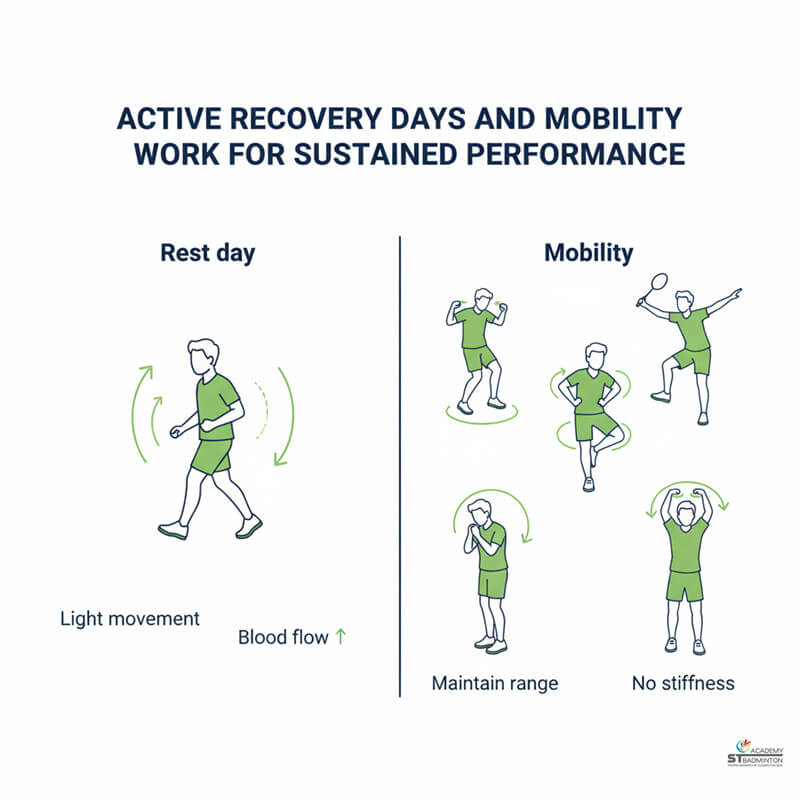
Recovery Strategy #2
Active Recovery Days And Mobility Work For Sustained Performance
Professional players schedule active recovery sessions between intense training days using low-intensity movement like easy cycling, brisk walking or gentle shadow footwork to promote blood flow and tissue repair without adding training stress. These light activities help clear residual fatigue and maintain movement quality better than complete rest alone, making them valuable for competitive juniors and adults in Malaysia and Singapore who train multiple times weekly and need strategies to manage accumulated load.
Players from Wangsa Maju, Ampang and Singapore areas like Ang Mo Kio or Yishun can implement active recovery by taking twenty to thirty minute walks on rest days, doing light stretching routines at home, or performing very easy shadow movement focusing on technique rather than speed or intensity. Our coaching team at ST Badminton Academy teaches that active recovery days are not wasted time but essential components of training cycles that allow hard sessions to produce adaptation rather than just fatigue.
Mobility work including gentle hip circles, ankle rotations, shoulder rolls and spinal twists helps maintain range of motion needed for badminton lunges, overhead shots and quick direction changes, with short daily sessions of five to ten minutes providing better results than occasional long stretching blocks that players across Kuala Lumpur and Singapore often skip due to time pressure or perceived low importance.
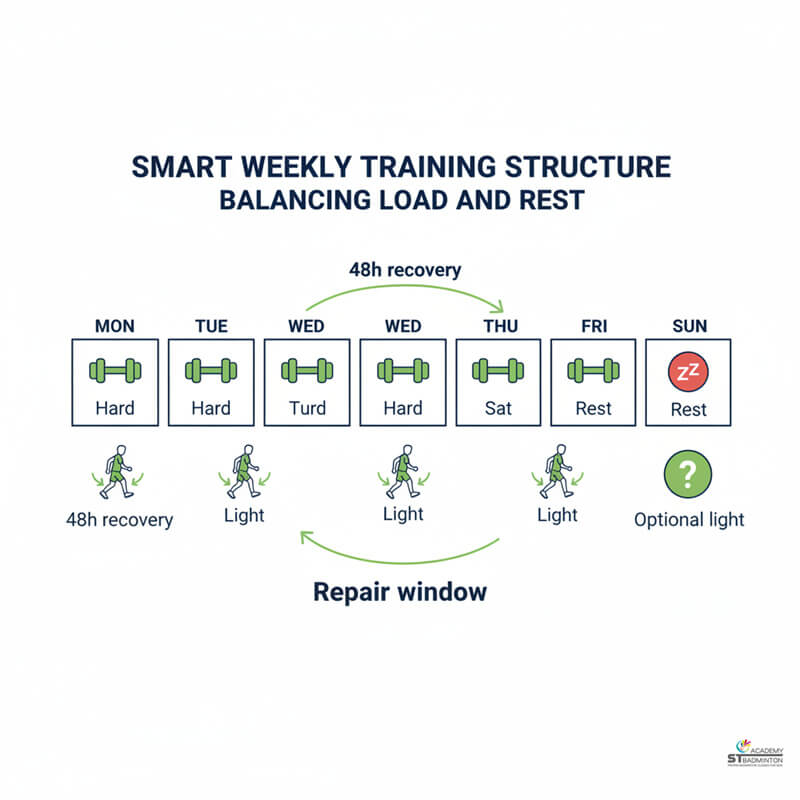
Recovery Strategy #3
Smart Weekly Training Structure Balancing Load And Rest
Professional players organize training weeks with deliberate variation between high-intensity and lower-intensity days, ensuring adequate recovery time allows previous hard sessions to produce adaptation rather than accumulating fatigue that degrades performance and increases injury risk. Club players in Malaysia and Singapore can apply this principle by avoiding stacking multiple intense badminton sessions on consecutive days without recovery periods, instead alternating hard training with lighter technical work or complete rest days.
School students from Setapak, Petaling Jaya, Puchong and Singapore office areas who juggle academic demands with badminton training should plan at least one complete rest day weekly where no structured training occurs, allowing physical recovery alongside mental refreshment from sport demands. Our certified coach at ST Badminton Academy helps families design realistic weekly schedules that respect recovery needs while maintaining progression, recognizing that young athletes training five to six days weekly without proper rest often plateau or develop overuse injuries.
Working adults training two to three evenings per week around jobs in Kuala Lumpur, Selangor and Singapore already have natural recovery built into schedules but should avoid compensating for missed sessions by adding extra intensity that exceeds capacity for adaptation, instead focusing on consistency at manageable loads that allow sustainable long-term participation in badminton without chronic fatigue or motivation loss.
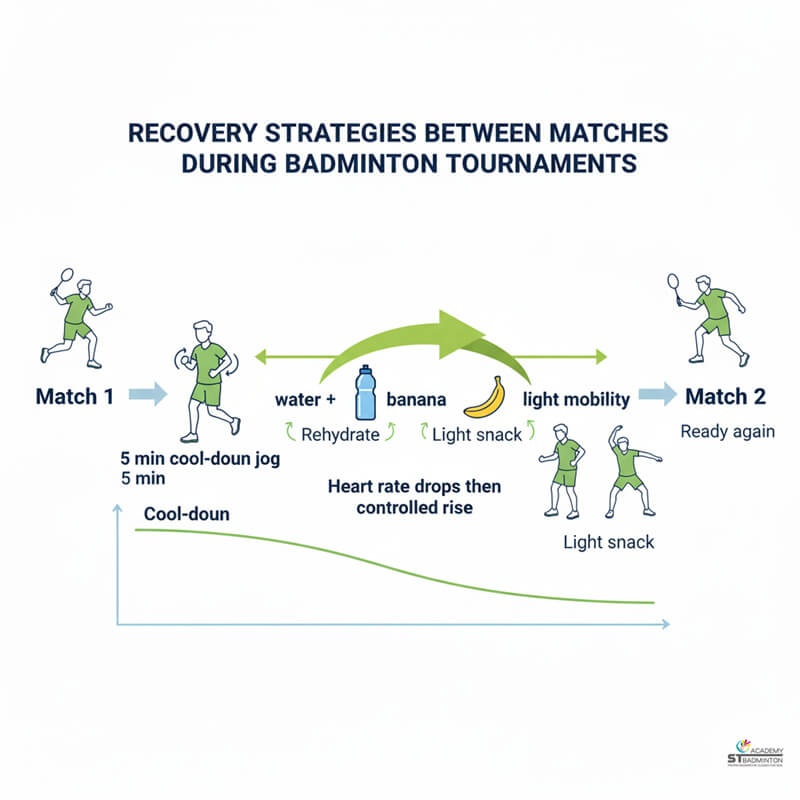
Tournament Recovery
Recovery Strategies Between Matches During Badminton Tournaments
Professional players follow specific protocols between tournament matches to maximize recovery in limited timeframes, including short cool-down routines immediately after each match, strategic rehydration and light nutrition intake, and controlled rest that maintains readiness without allowing muscles to stiffen completely. These tournament recovery strategies scale effectively for school and club competitions across Malaysia and Singapore where players often compete multiple times in single days with one to three hour gaps between matches.
Competitive juniors from Selayang, Gombak and areas around Toa Payoh or Tampines should complete five-minute easy jogs and basic stretching immediately post-match rather than sitting down for extended periods, then consume small recovery snacks with fluids during the rest interval while avoiding heavy meals that impair digestive comfort for subsequent play. Our coaching team at ST Badminton Academy teaches tournament routines including light mobility work and mental relaxation techniques during longer breaks rather than intense practice drills that deplete energy reserves needed for elimination rounds.
After full tournament days involving multiple matches, players should prioritize sleep quality that night through simple wind-down routines like gentle stretching, cool showers and reduced screen stimulation, ensuring the body enters deep recovery phases that repair accumulated micro-damage from repeated high-intensity efforts throughout competition days in humid Malaysian and Singaporean venues.
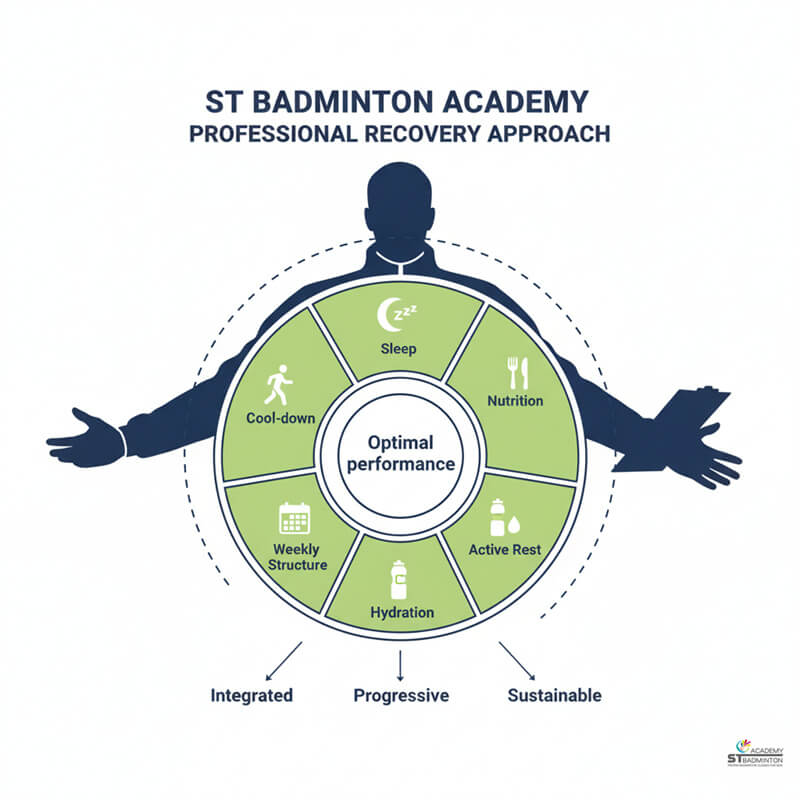
Why Choose Us
ST Badminton Academy Professional Recovery Approach
At ST Badminton Academy in Kuala Lumpur, we teach school team players, serious juniors and busy adults how to optimize badminton recovery using practical strategies inspired by professional player routines adapted for real-world schedules and constraints. Our certified coach integrates recovery education into regular training, emphasizing that consistent sleep habits, proper post-session nutrition, structured cool-downs and smart load management produce better long-term results than sporadic use of expensive recovery equipment or complex protocols.
Players from Setapak, Wangsa Maju, Selayang and surrounding areas learn that recovery is active training component deserving equal attention to on-court skill development, with small daily habits like adequate hydration, regular mobility work and appropriate rest days compounding into significant performance advantages over months and years. We provide individualized guidance on balancing training intensity with recovery capacity for students managing academic demands and working adults fitting badminton around job responsibilities.
Families from Cheras, Ampang, Petaling Jaya and Singapore areas like Hougang, Sengkang or Punggol appreciate that we prioritize sustainable training approaches over short-term intensity that leads to burnout or overuse injuries in young athletes. Contact us to learn how professional-style recovery strategies can help you train more consistently and perform better across Malaysia and Singapore.
FAQs: Recovery For Badminton Players
Here are answers to common questions about optimizing badminton recovery using professional player strategies for Malaysia and Singapore players.
How much rest do I need between badminton training sessions in Kuala Lumpur and Singapore?
Most players need at least twenty-four hours between intense badminton sessions to allow adequate muscle recovery and energy restoration, with one complete rest day weekly recommended for sustainable training. Players in Setapak and Wangsa Maju training three to four times per week should avoid scheduling hard sessions on consecutive days without recovery periods. Our certified coach at ST Badminton Academy adjusts rest recommendations based on individual training intensity, age and recovery capacity, recognizing that young athletes and working adults often need different recovery timelines.
What recovery routine do professional badminton players follow in Malaysia?
Professional players prioritize consistent sleep schedules of seven to nine hours, structured cool-downs after every session, proper hydration and nutrition within two hours post-training, regular mobility work and strategic rest days in weekly plans. Players in Kuala Lumpur and Selangor can adapt these habits by focusing on sleep quality first, completing ten-minute cool-downs consistently, eating balanced meals after training and scheduling at least one rest day weekly rather than pursuing expensive recovery equipment that provides marginal benefits without foundational habits.
Do I really need ice baths or massage after badminton training in Singapore?
Ice baths, massage and compression garments are optional recovery tools that provide modest benefits but are not necessary for most club players in Singapore areas like Jurong, Clementi and Bishan who train recreationally. Focus first on free or low-cost recovery fundamentals including adequate sleep, proper nutrition, consistent cool-downs and smart training load management. Professional players use these tools during heavy competition periods, but research shows basic recovery habits produce larger performance gains for typical badminton players than expensive modalities.
How can school players balance study, training and recovery in Malaysia?
School students in Selayang, Sentul and Gombak should prioritize consistent sleep schedules even during exam periods, protect at least one complete rest day weekly from both sport and intensive studying, and communicate openly with coaches about academic load fluctuations. Our certified coach at ST Badminton Academy helps families design realistic training schedules that reduce intensity during exam weeks while maintaining some activity, recognizing that complete cessation often makes return to full training more difficult than strategic load management throughout academic cycles.
What are simple recovery tips for adult badminton players with busy jobs in Singapore?
Working adults in Petaling Jaya, Subang Jaya and Singapore areas like Ang Mo Kio or Yishun should protect sleep quality over adding extra training sessions, complete brief cool-downs even when time-pressed after evening games, stay consistently hydrated throughout workdays, and schedule light mobility work during lunch breaks or before bed. Focus on training consistency at sustainable intensity rather than sporadic high-volume weeks followed by forced rest from fatigue or minor injuries, recognizing that long-term participation requires balancing work stress with badminton load.
How do I know if I am not recovering enough between badminton sessions in Kuala Lumpur?
Warning signs of inadequate recovery include unusual muscle soreness lasting more than seventy-two hours, persistent fatigue despite rest days, declining performance or concentration during training, disrupted sleep patterns, increased irritability and frequent minor injuries or illness. Players in Kuala Lumpur and Selangor experiencing these symptoms should reduce training intensity or volume, prioritize sleep and nutrition quality, and consult coaches about load management. Our certified coach at ST Badminton Academy encourages simple training logs tracking energy levels and soreness to identify recovery issues early.
Should young badminton players do the same recovery routines as adults in Malaysia?
Young players need more sleep than adults for growth and development, typically nine to ten hours for school-age children and eight to nine for teenagers training regularly. Juniors from Cheras, Ampang and Puchong should avoid late-night training sessions that compromise sleep quality, prioritize simple cool-downs and mobility work suitable for developing bodies, and have lighter overall training loads than adults. ST Badminton Academy designs age-appropriate recovery protocols recognizing that young athletes require different rest patterns and should not simply copy professional or adult routines without modification.
What should I eat after badminton training for better recovery in Singapore?
Consume meals or snacks containing carbohydrates plus protein within one to two hours post-training to support muscle repair and energy restoration, using accessible Singapore and Malaysian foods like rice with chicken or fish, noodle dishes with lean protein, fruits with yogurt, or simple sandwiches. Focus on regular balanced meals rather than expensive supplements, ensuring adequate overall daily nutrition supports training demands. Rehydrate consistently with water throughout recovery periods, adding electrolytes during particularly long or intense sessions in humid conditions.
When should I see a doctor about recovery problems in Malaysia?
Consult a doctor or physiotherapist if you experience persistent pain lasting beyond normal post-training soreness, significant swelling or joint instability, chronic fatigue despite adequate rest, or repeated injuries affecting the same body areas. Normal muscle soreness should resolve within forty-eight to seventy-two hours, while symptoms lasting longer or worsening over time require professional assessment. Our certified coach at ST Badminton Academy in Setapak and Wangsa Maju encourages players to seek medical advice early rather than training through serious issues that worsen without proper treatment.
Professional Recovery in Action
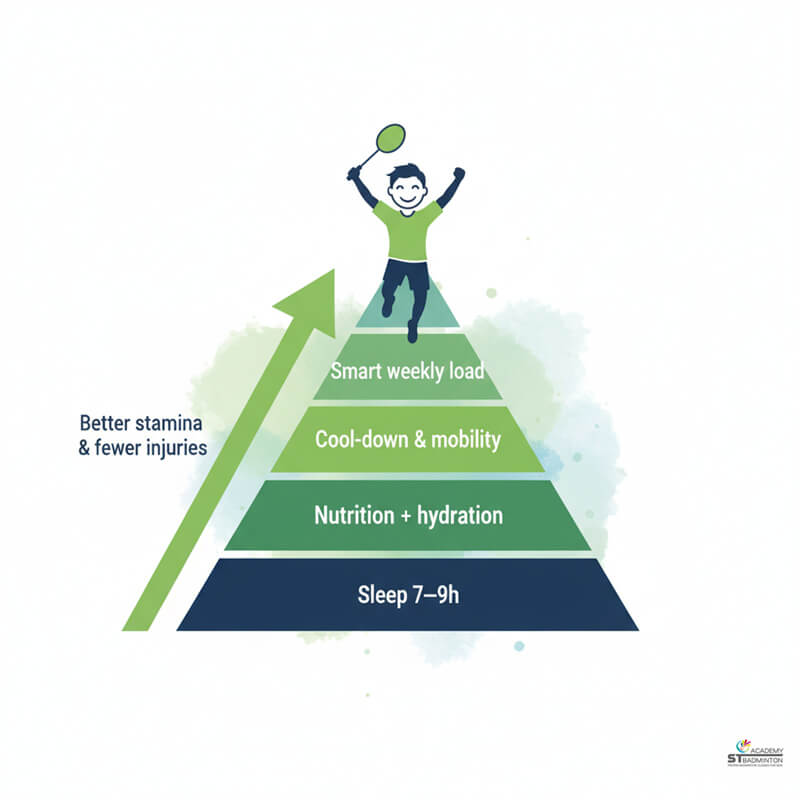
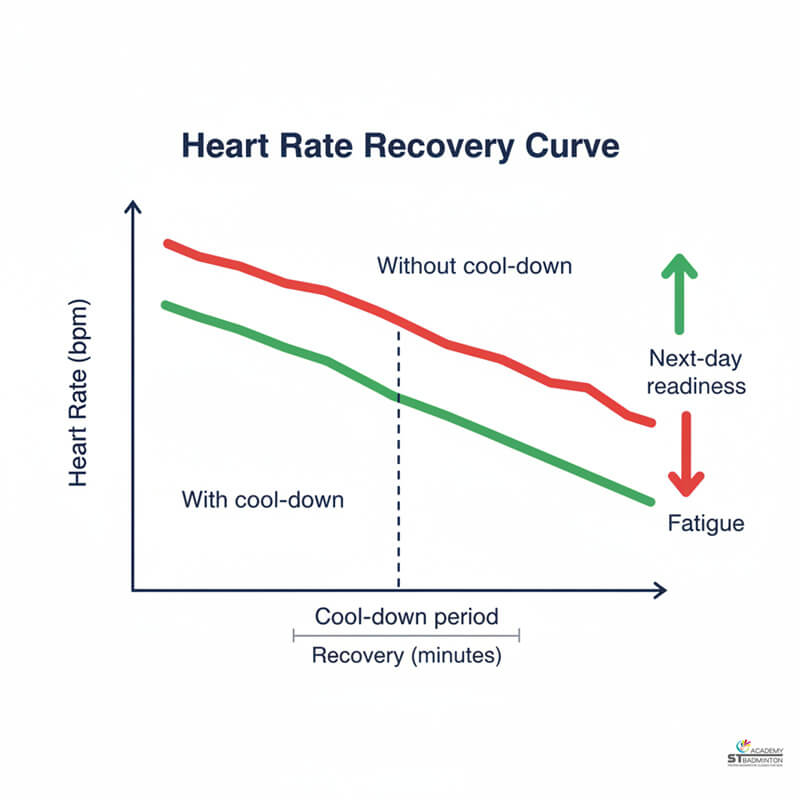
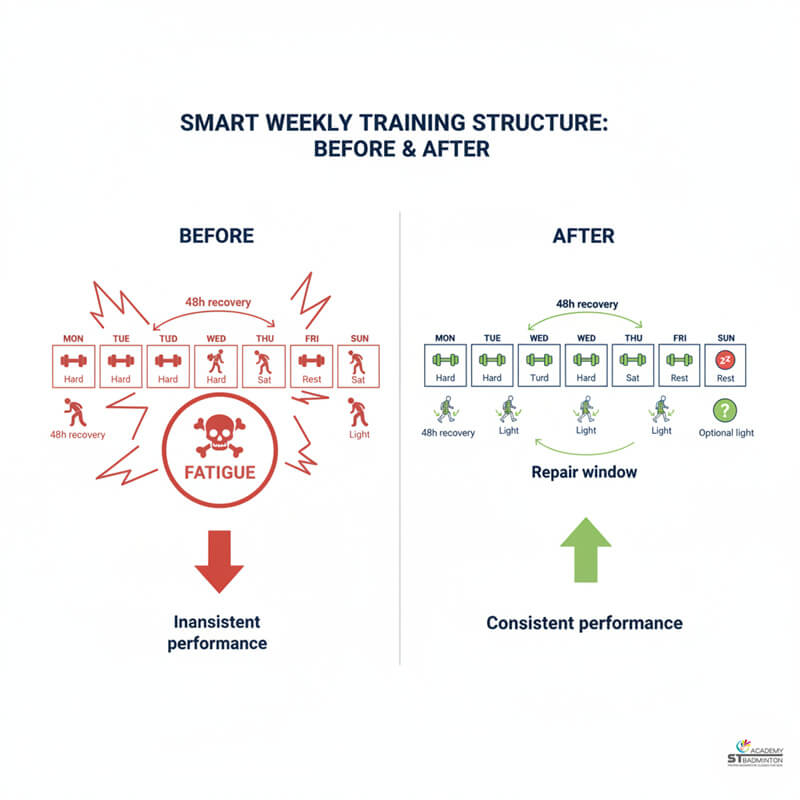
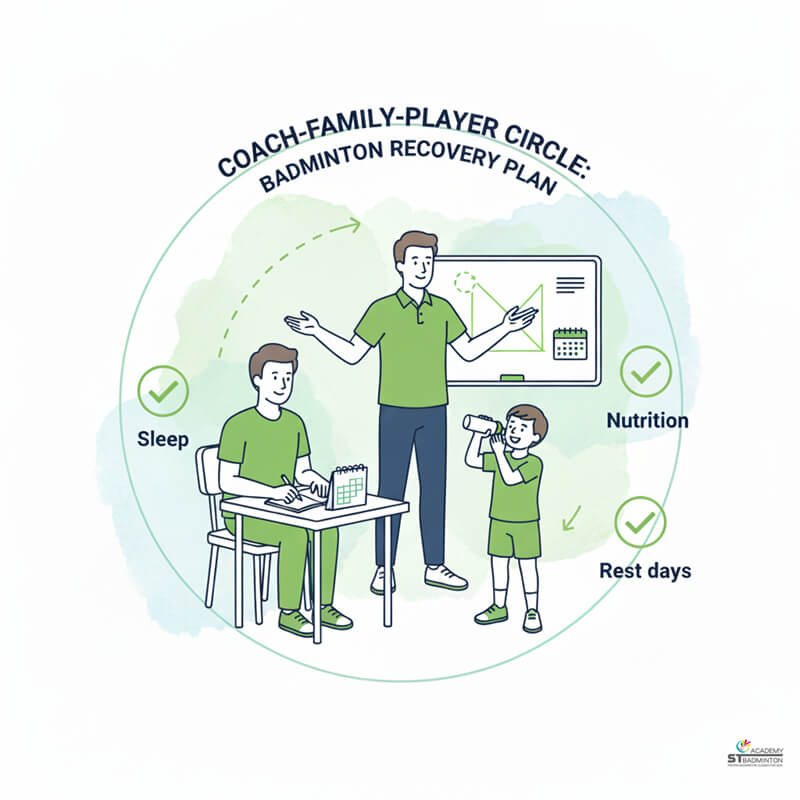
Benefits of Professional Recovery Habits
Adopting recovery strategies used by professional badminton players helps Malaysia and Singapore players train more consistently, reduce injury risk and improve long-term performance through better adaptation to training loads. Our certified coach teaches practical recovery habits that fit into real-world schedules for school students and working adults.
| Recovery Aspect | Random Recovery Approach | Professional Recovery Strategy EFFECTIVE |
|---|---|---|
| Sleep Habits | Irregular sleep times and inadequate total hours. Screen use until bedtime disrupting rest quality. | Consistent seven to nine hour schedule with bedtime routines. Sleep protected as primary recovery tool. |
| Post-Training Routine | Rush off court immediately. No cool-down or stretching after intense sessions. | Structured cool-down with light movement and stretching every session. Ten minutes invested protecting next days. |
| Nutrition Timing | Skip meals or eat randomly hours after training. Inadequate hydration throughout day. | Recovery meal within one to two hours post-training. Consistent hydration before during and after sessions. |
| Weekly Structure | Stack hard sessions consecutively without recovery. No planned rest days in schedule. | Alternate hard and light days strategically. At least one complete rest day weekly for adaptation. |
| Active Recovery | Complete inactivity on rest days. No attention to mobility or movement quality. | Light movement like walking or easy cycling on rest days. Short daily mobility work maintaining range. |
| Tournament Recovery | Sit down immediately between matches. Eat heavy meals during competition breaks. | Light cool-down jog and stretch after each match. Small recovery snacks with steady hydration between rounds. |
| Long-Term Results | Chronic fatigue and declining performance. Frequent injuries from accumulated load without recovery. | Sustainable improvement and consistent training. Better adaptation and reduced injury risk from proper recovery. |
Professional Recovery Training in Kuala Lumpur and Singapore
This guide helps badminton players in Malaysia and Singapore optimize recovery using practical strategies inspired by professional player routines adapted for real-world constraints of school, work and busy family schedules. ST Badminton Academy provides integrated recovery education for school team players, serious juniors and busy adults in Setapak, Wangsa Maju, Selayang, Kepong, Cheras and surrounding areas. If you want coaching that teaches recovery as essential training component alongside technical and tactical development, contact us to learn how professional-style recovery habits can help you train more consistently and perform better across Malaysia and Singapore. Remember: Persistent pain, unusual fatigue or injury concerns require professional medical assessment from a doctor or physiotherapist.

